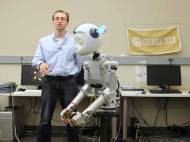Teaching robots to move more human-like
 When people communicate, the way they move has as much to do with what they’re saying as the words that come out of their mouths. Researchers at the Georgia Institute of Technology found that when robots move in a more human-like fashion, with one movement leading into the next, that people can not only better recognize what the robot is doing, but they can also better mimic it themselves.
When people communicate, the way they move has as much to do with what they’re saying as the words that come out of their mouths. Researchers at the Georgia Institute of Technology found that when robots move in a more human-like fashion, with one movement leading into the next, that people can not only better recognize what the robot is doing, but they can also better mimic it themselves.
“It’s important to build robots that meet people’s social expectations because we think that will make it easier for people to understand how to approach them and how to interact with them”, said Andrea Thomaz, assistant professor in the School of Interactive Computing at Georgia Tech’s College of Computing.
Thomaz, along with Ph.D. student Michael Gielniak, conducted a study in which they investigated how easily people can recognize what a robot is doing by watching its movements.
“Robot motion is typically characterized by jerky movements, with a lot of stops and starts, unlike human movement which is more fluid and dynamic”, said Gielniak. “We want humans to interact with robots just as they might interact with other humans, so that it’s intuitive.”
By using a series of human movements taken in a motion-capture lab, they programmed the robot named Simon to perform the movements. They also optimized the motion in order to enable more joints to move simultaneously, and it made the movements to flow into each other more naturally and human-like.
Afterward, they asked their human subjects to watch Simon and identify the movements he made. According to researchers, when the motion was more human-like, the observing human subjects were able to watch the motion and perceive what the robot was doing more easily.
In addition, they tested the algorithm they used to create the optimized motion by asking humans to perform the movements they saw Simon making. The researcher’s assumption that if the movement created by the algorithm was indeed more human-like, then the subjects should have an easier time mimicking it was also right.
“We found that this optimization we do to create more life-like motion allows people to identify the motion more easily and mimic it more exactly”, said Thomaz.
The research that Thomaz and Gielniak are doing is part of a theme in getting robots to move more like humans move. In future work, the pair plan on looking at how to get Simon to perform the same movements in various ways.
“So, instead of having the robot move the exact same way every single time you want the robot to perform a similar action like waving, you always want to see a different wave so that people forget that this is a robot they’re interacting with”, said Gielniak.









Hmm, I’m bothered only about one thing. If they introduce random movements and don’t work on increased safety algorithms, there is a possibility that robot might do what we don’t expect of it and cause potential injuries.